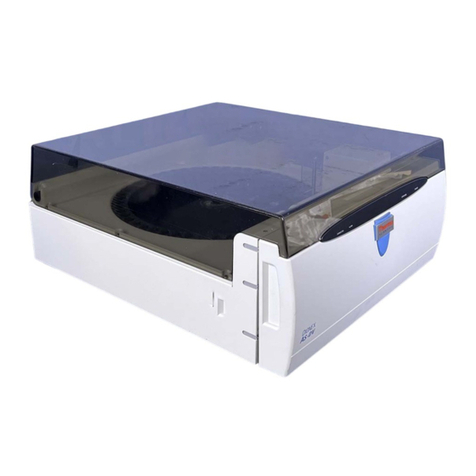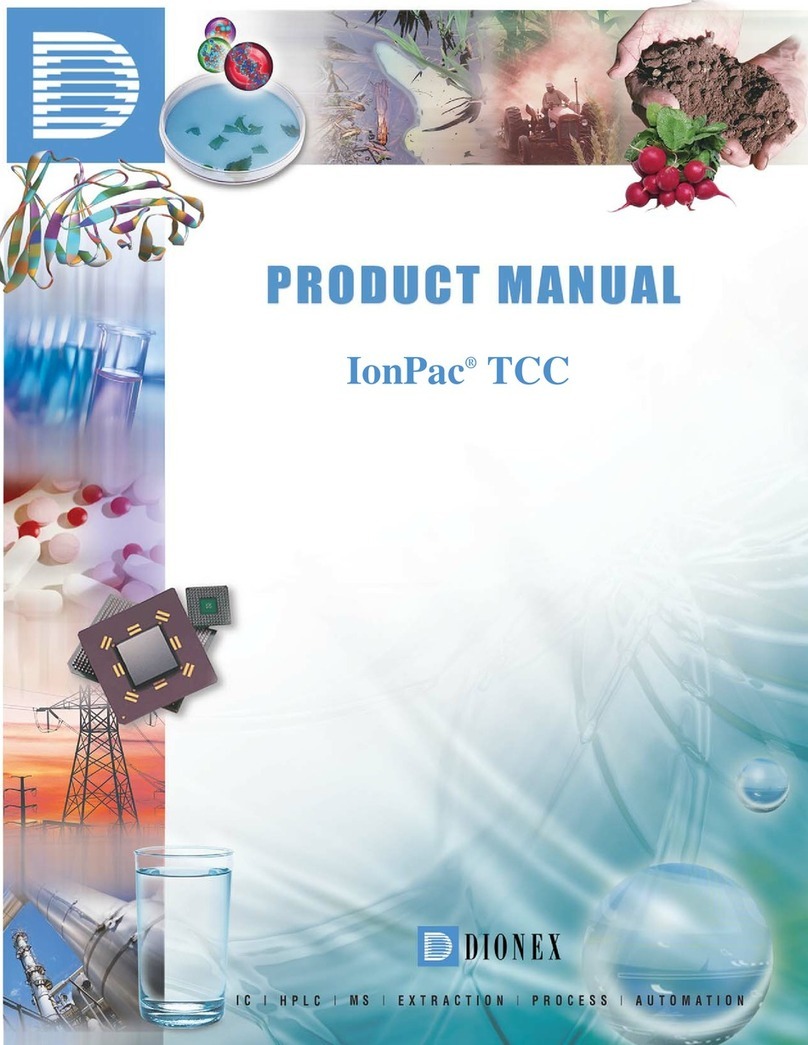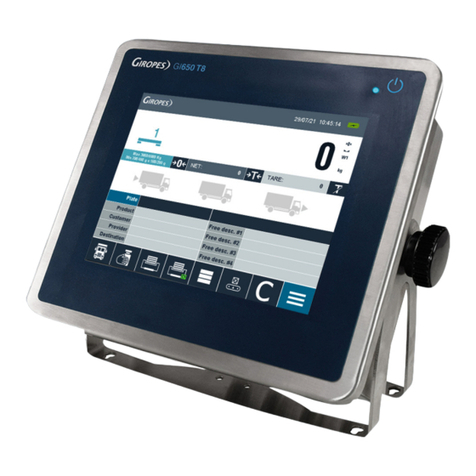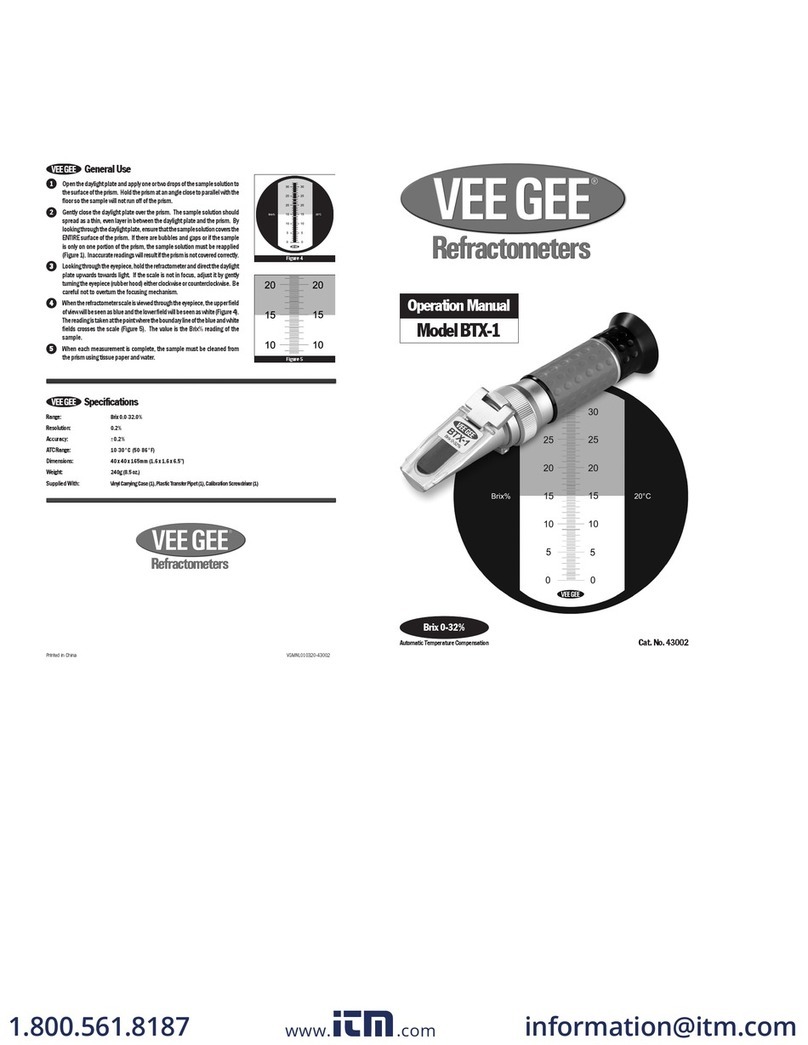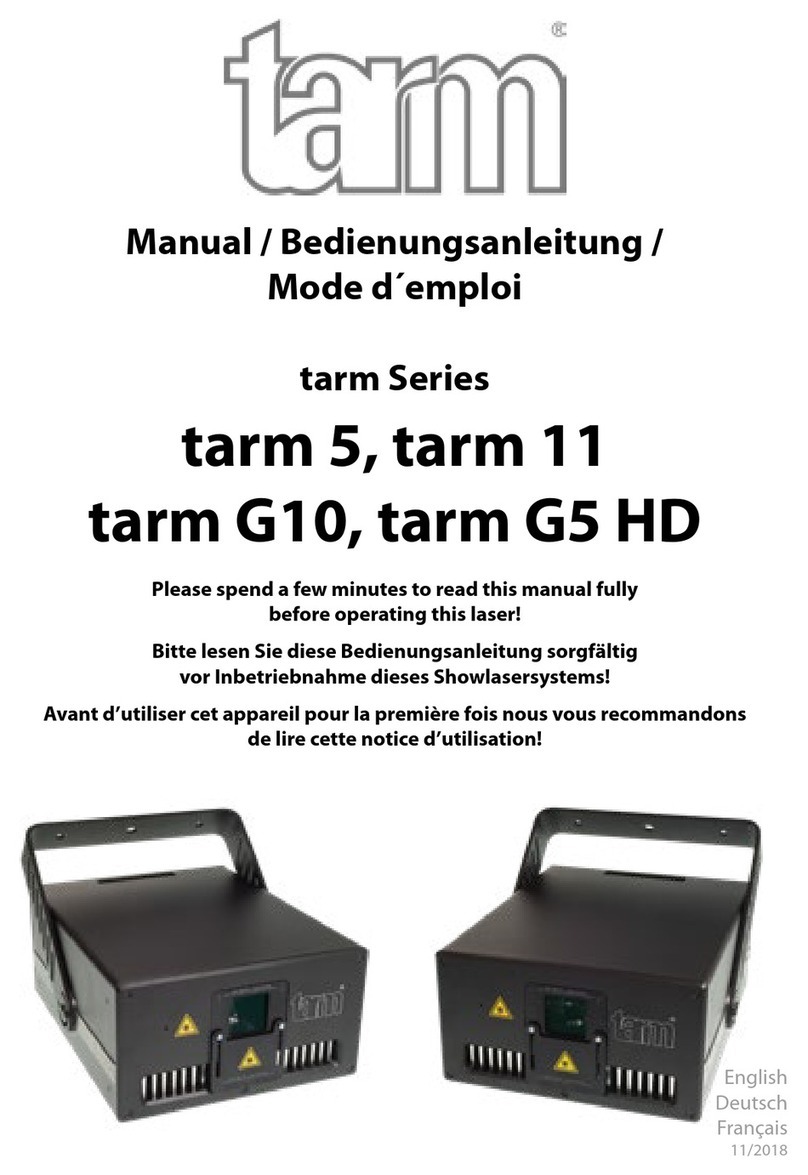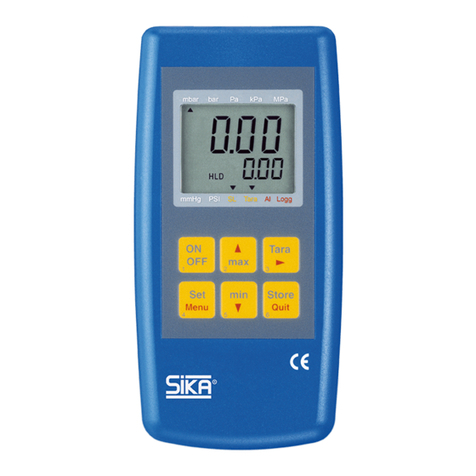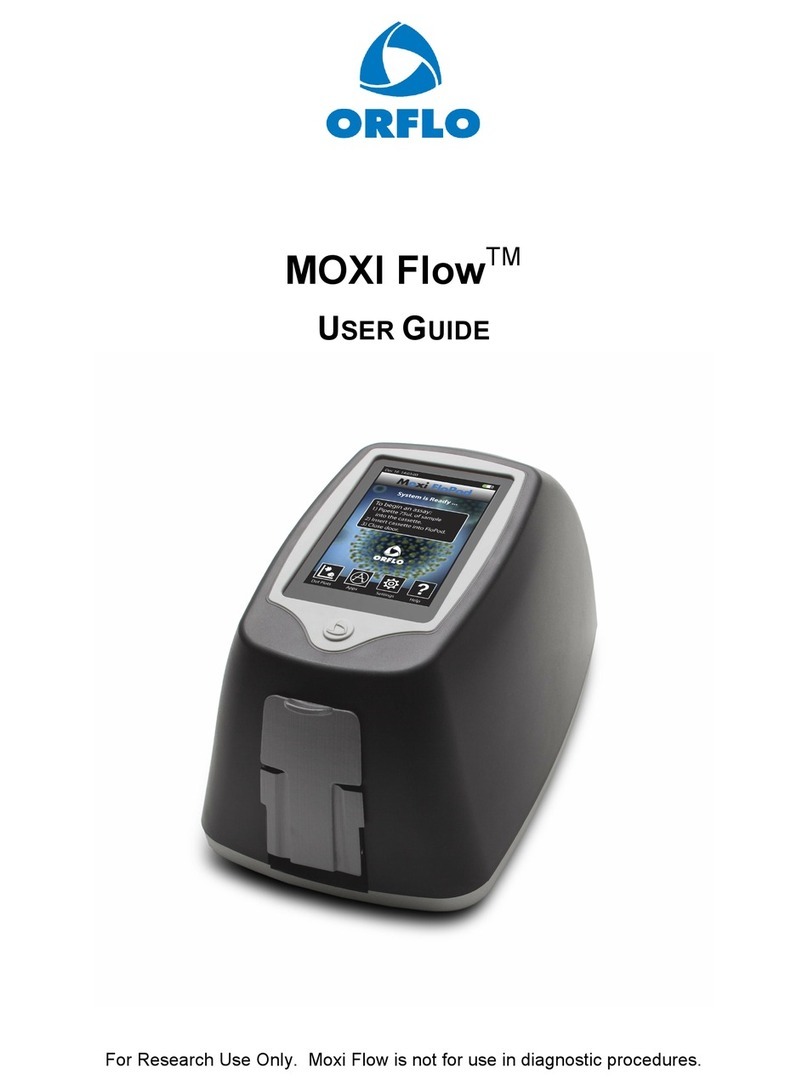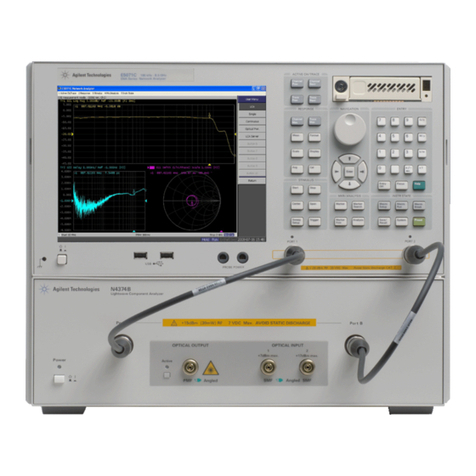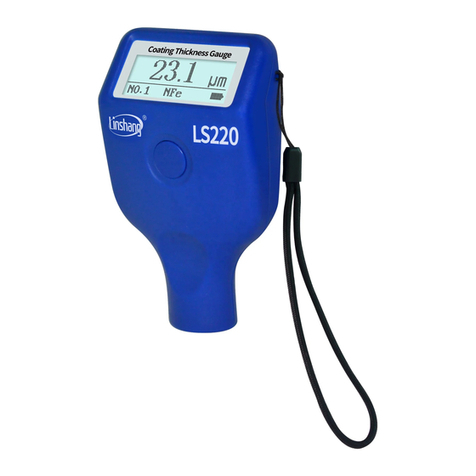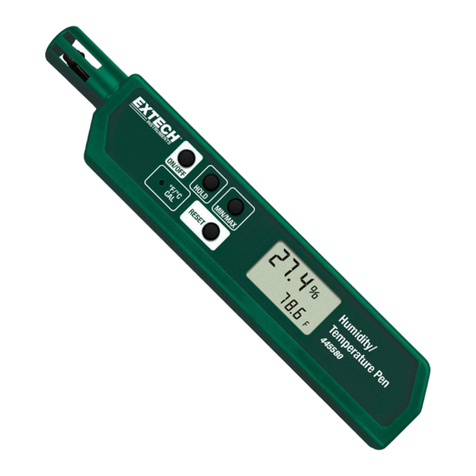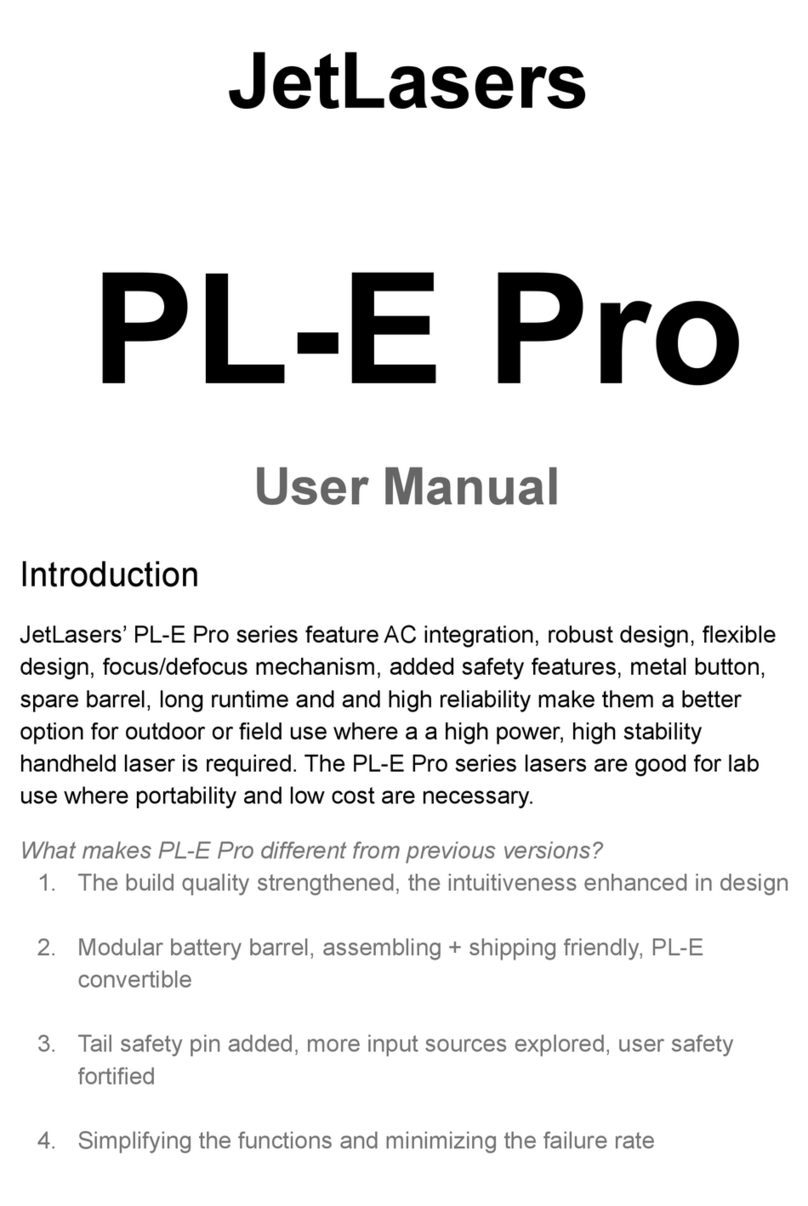Dionex IONPAC NG1 User manual

PRODUCT MANUAL
IONPAC®NG1 GUARD COLUMN
(4 x 50 mm, P/N 039567)
IONPAC®NS1 ANALYTICAL COLUMN
(4 x 250 mm, P/N 035321)
IONPAC®NS1-5µm ANALYTICAL COLUMN
(4 x 150 mm, P/N 059568)
©DIONEX Corporation, 1997-2004
Document No. 034024
Revision 06
15 January 2004
QUICKSTART STEPS AND LINKS
Click blue text below to get started.
1. The standard test eluent for the IonPac NS1 is 3 mM Tetrabutylammonium hydroxide/28%
Acetonitrile. See Section 3.4, “Preparing Eluents with Solvents”. Make the required stock
and working solutions for eluents. See Section 3, “Operation,” for details. Note operation
precautions and chemical purity requirements.
2. Run the Production Test Chromatogram as a system check. See Section 4.1.1, “Production
Test Chromatogram,” for details.
3. See Section 4, “Applications” for example applications.
4. See “Column Care” for column cleanup and long-term storage recommendations.

IonPac NS1 Manual Document No. 034024-06 Page 2 of 35
TABLE OF CONTENTS
SECTION 1 - INTRODUCTION ...................................................................................................... 4
SECTION 2 - INSTALLATION........................................................................................................6
2.1 System Requirements .............................................................................................................................................. 6
2.2 The System Injection Loop, 10 - 15 µL ............................................................................................................... 6
2.3 The IonPac Anion Trap Column ............................................................................................................................ 6
2.4 The IonPac NG1 Guard Column ........................................................................................................................... 7
2.5 Eluent Storage .......................................................................................................................................................... 7
2.6 Anion Self-Regenerating Suppressor Requirements............................................................................................ 7
2.7 Detector Requirements ............................................................................................................................................ 8
SECTION 3 - OPERATION .............................................................................................................. 9
3.1 General Operating Conditions ............................................................................................................................... 9
3.2 IonPac NS1 Operation Precautions ....................................................................................................................... 9
3.3 Chemical Purity Requirements .............................................................................................................................. 9
3.3.1 Inorganic Chemicals .................................................................................................................................................. 9
3.3.2 Deionized Water ........................................................................................................................................................ 9
3.3.3 Solvents...................................................................................................................................................................... 9
3.3.4 Acid Modifiers......................................................................................................................................................... 10
3.3.5 Base Modifiers......................................................................................................................................................... 10
3.4 Preparing Eluents that Contain Solvents ............................................................................................................ 10
3.4.1 Eluents for Reversed-Phase and Ion Suppression.....................................................................................................11
3.4.2 Eluents for Gradients ................................................................................................................................................11
3.4.3 Eluents for Mobile Phase Ion Chromatography (MPIC) ..........................................................................................11
3.5 Regenerant Preparation for the Self-Regenerating Suppressors ...................................................................... 11
3.6 Regenerant Preparation for the AMMS-ICE II ................................................................................................. 12
3.7 Using AutoRegen and Eluents Containing Solvents .......................................................................................... 12
3.7.1 ASRS ULTRA II in MPIC Suppression or Chemical Suppression Mode ............................................................... 12
3.7.2 CSRS ULTRAII in Chemical Suppression.............................................................................................................. 13
3.8 Using Pressurized Regenerant Reservoir with the AMMS-ICE II ..................................................................13

IonPac NS1 Manual Document No. 034024-06 Page 3 of 35
SECTION 4 - APPLICATIONS ...................................................................................................... 14
4.1 Ion Pair Chromatography .................................................................................................................................... 14
4.1.1 Production Test Chromatogram ............................................................................................................................... 15
4.1.2 Separation ofAnions by MPIC with Suppressed Conductivity Detection and Solvent........................................... 16
4.1.3 Separation ofAliphatic SulfonicAcids by Ion-Pairing with Suppressed Conductivity (MPIC).............................. 17
4.1.4 Separation ofAromatic SulfonicAcids Using Ion-Pairing with Suppressed Conductivity ..................................... 18
4.1.5 Separation ofAliphatic Quaternary Ammonium Ions Using Ion-Pairing with Suppressed Conductivity (MPIC) .. 19
4.1.6 Separation ofAlkanolamines Using Ion-Pairing with Suppressed Conductivity (MPIC) ....................................... 20
4.2 Ion Suppression Chromatography ....................................................................................................................... 21
4.2.1 Water Soluble Vitamins by Ion Pairing / Ion Suppression Chromatography ........................................................... 22
4.2.2 Water Soluble Vitamins by Ion Suppression / Ion Pair Chromatography ................................................................ 22
4.2.3 Separation of Benzoic Acid and o-nitrobenzoic Acid.............................................................................................. 23
4.2.4 Gradient Separation ofAliphatic Carboxylic Acids................................................................................................. 24
SECTION 5 - TROUBLESHOOTING .......................................................................................... 25
5.1 High Back Pressure ............................................................................................................................................... 26
5.1.1 Finding the Source of High System Pressure........................................................................................................... 26
5.1.2 Replacing Column Bed SupportAssemblies ........................................................................................................... 27
5.2 High Background or Noise ................................................................................................................................... 27
5.2.1 Preparation of Eluents.............................................................................................................................................. 27
5.2.2 ContaminatedAnion Trap Column, theATC-3 (4-mm)........................................................................................... 28
5.2.3 Contaminated Guard orAnalytical Column............................................................................................................. 28
5.2.4 Contaminated Hardware .......................................................................................................................................... 28
5.2.5 Contaminated Suppressor ....................................................................................................................................... 28
5.3 Poor Peak Resolution ............................................................................................................................................ 29
5.3.1 Loss of Column Efficiency ...................................................................................................................................... 29
5.3.2 Poor Resolution Due to Shortened Retention Times ............................................................................................... 29
5.3.3 Loss of Front End Resolution .................................................................................................................................. 30
5.4 Spurious Peaks ....................................................................................................................................................... 30
5.5 Small Analyte Peak Areas ..................................................................................................................................... 31
APPENDIX A - QUALITY ASSURANCE REPORT.................................................................... 32
A.1 IonPac NS1 10µm .................................................................................................................................................. 32
A.2 IonPac NS1 5µm .................................................................................................................................................... 33
APPENDIX B - COLUMN CARE .................................................................................................. 34
B.1 Recommended Operation Pressures .................................................................................................................... 34
B.2 Column Start-Up ................................................................................................................................................... 34
B.3 Column Storage ..................................................................................................................................................... 34
B.4 Column Cleanup .................................................................................................................................................... 34
B.4.1 Choosing the Appropriate Cleanup Solution ........................................................................................................... 35
B.4.2 Column Cleanup Procedure ..................................................................................................................................... 35

IonPac NS1 Manual Document No. 034024-06 Page 4 of 35
Table 1
IonPac NS1/NG1 Packing Specifications
Column Particle Substrate
Diameter X-linking
µm %
IonPac NS1 analytical column 10 55
4 x 250 mm
IonPac NG1 guard column 10 55
4 x 35 mm
IonPac NS1-5 µm analytical column 5 55
4 x 150 mm
Always remember that assistance is available for any problem that may be encountered during the shipment or
operation of Dionex instrumentation and columns through the Dionex North America Technical Call Center at
1-800-DIONEX-0 (1-800-346-6390) or through any of the Dionex Offices.
SECTION 1 - INTRODUCTION
The IonPac®NS1 (10-micron packing) and the IonPac®NS1-5µm (5-micron packing) analytical columns are polymer-based
reversed-phasecolumns fortheanalysis ofionicand nonpolarorganiccompounds. Thepackingmaterial isahighly cross-linked,
macroporous copolymer with a very high hydrophobic surface area. The 5-micron version provides higher efficiencies than the
10-micron version. A great advantage of polymer-based packings is their chemical inertness not only to commonly used HPLC
solventsbutalsoto the full pH range from0to14.Often organic analytes of interest tothechromatographerare ionized at neutral
pH. Ion suppression chromatography can often be used to great advantage to control the adsorption of ionizable molecules to the
column packing through eluent pH adjustments and therefore control their resulting retention times. This translates to more
resolvingpower and greatersensitivity.The Anion ICEIIMicroMembrane Suppressor (AMMS®-ICEII)is a high-capacity,low
void volume dynamic eluent suppressor designed for use with ion exclusion and ion suppression separation modes of ion
chromatography.
Many analytes of interest are neither ionizable nor UV detectable. Organic and inorganic anions and cations which are not UV
detectable can be analyzed using Mobile Phase Ion Chromatography (MPIC®) coupled with suppressed conductivity detection.
In these analyses, ionic analytes are complexed in the mobile phase with an ion pair reagent. Separations are achieved through a
two fold mechanism. The first consideration is the degree of adsorption that takes place between the hydrophobic portion of the
ionpairreagentandthecolumnpacking.Thisvarieswiththelengthofthehydrophobicportionoftheionpairreagent.Thesecond
consideration is the stability of the ion pair complex between the ion pair reagent and the analyte ion. This can be varied by the
addition of salts to the eluent.
The suppressor for Anion-MPIC is the Anion Self-Regenerating Suppressor® ULTRA II (ASRS ULTRA II), which is designed
tosuppresstetraalkylammoniumpairingreagents.Note:theAnionMicroMembraneSuppressor(AMMSIII)cannotbeusedwith
MPIC. The suppressor for Cation-MPIC is the Cation Self-Regenerating Suppressor®ULTRA II (CSRS ULTRA II), which can
also be used to suppress conventional cation-exchange eluents. Both the ASRS ULTRA II and CSRS ULTRA II are compatible
withtypicalorganicsolventsupto40%byvolumeusedinreversed-phaseion-pairchromatography.Theexternalwatermodemust
be used for eluents containing organic solvent.
This manual assumes that you are familiar with the installation and operation of the Dionex Ion Chromatograph (IC). If you do
not understand the operation of the system, take the time to familiarize yourself with the various system components before
beginning an analysis.

IonPac NS1 Manual Document No. 034024-06 Page 5 of 35
Table 2
NS1/NG1 Operating Parameters
Standard Maximum
Column Typical Back Pressure Flow Rate Flow Rate
psi (MPa) mL/min mL/min
NS1 Analytical 900 (6.21) - 1,400 (9.66) 1.0 3.0
NG1 Guard 200 (1.38) - 300 (2.07) 1.0 3.0
NS1 + NG1 columns 1,100 (7.59) - 1,700 (11.73) 1.0 3.0
NS1-5 µm analytical 1,700 (11.73) - 2,500 (17.24) 1.0 1.5
NG1 Guard 200 (1.38) - 300 (2.07) 1.0 1.5
NS1-5 µm + NG1 columns 1,900 (13.11) - 2,800 (19.31) 1.0 1.5

IonPac NS1 Manual Document No. 034024-06 Page 6 of 35
SECTION 2 - INSTALLATION
2.1 System Requirements
TheIonPacNS1GuardandanalyticalcolumnscanberunonanyPEEKDionexChromatograph.Dependingupontheapplication,
the system should be equipped with either a conductivity detector and an ASRS ULTRA II for MPIC applications or a UV/Vis
detector for reversed-phase and ion pair applications. Gradient or isocratic methods should be performed on a system having a
gradientpumpconfiguredforstandardboreoperation.Forisocraticanalysesatflowratesbelow0.5mL/minandgradientanalyses,
a gradient pump (1/16" pistons) must be employed.
2.2 The System Injection Loop, 10 - 15 µL
For most applications on a 4-mm analytical system, a 10–50 µL injection loop will be sufficient. Dionex recommends that a 10
µL injection loop be used to avoid overloading the IonPac NS1 4-mm analytical column. Generally, do not inject more than 10
nanomoles (100–200 ppm) of any one analyte onto the 4-mm analytical column. Injecting larger volumes of samples can result
in overloading the column which can affect the detection linearity. This phenomenon will be more prevalent at higher
concentrations of the analytes of interest.
2.3 The IonPac Anion Trap Column
GradientorstepchangeapplicationsforanionMPICrequireanIonPacAnionTrapColumn(ATC-3(4-mm),P/N037151);cation
MPIC applications require an IonPac Cation Trap Column (CTC-1 (4-mm), P/N 040192). The IonPac Trap Column should be
installedinplaceofthehighpressuregradientmixerbetweenthegradient pumpandtheinjectionvalve.TheIonPacTrapColumn
is filled with high capacity ion exchange resin which helps to minimize the baseline shift caused by increasing ionic contaminant
levels in the eluent as the ionic concentration of the eluent is increased over the course of the gradient analysis.
To install the IonPac Trap Column, complete the following steps:
A. Remove the gradient mixer. It is installed between the gradient pump pressure transducer and the injection valve.
B. ConnectthegradientpumpdirectlytotheIonPacTrapColumn.Connectawastelinetothetrapcolumnoutletanddirect
the line to a waste container.
C. If you are doing anion MPIC regenerate the ATC-3. Use 200 mL of 200 mM NaOH at a flow rate of 2.0 mL/min. Note
that the guard and analytical column are out of line.
D. Rinse the IonPac Trap Column with 30 mL of the strongest eluent that will be used during the gradient analysis.
E. ConnecttheIonPacTrapColumn,afterflushingitwitheluent,totheeluentlinethatisconnectedtotheinjectionvalve.
At the end of each operating day, the IonPac Trap Column should be regenerated to remove any impurities that may have
accumulated on it.
A. Disconnect the ATC-3 or the CTC-1. It should be installed before the injection valve.
B. Direct the outlet of the ATC-3 or the CTC-1 to a separate waste container.
C. RegeneratetheATC-3ortheCTC-1.FordetailinformationontheoperationontheATC-3ortheCTC-1,seeDocument
No. 032697 for the ATC-3 and Document No. 034536 for the CTC-1.

IonPac NS1 Manual Document No. 034024-06 Page 7 of 35
On the next day, prior to the use of the chromatographic system, rinse the IonPac Trap Column. This will help with equilibration
times.
A. Rinse the TC-1 with 30 mL of the strongest eluent used in the gradient analysis.
B. Reconnect the IonPac Trap Column, after flushing it with eluent, to the eluent line that is connected to the injection
valve.
2.4 The IonPac NG1 Guard Column
An IonPac NG1 Guard Column is normally used with the IonPac NS1 analytical column. Retention times will increase by
approximately20%whenaguardcolumnisplacedin-linepriortotheanalyticalcolumn.Aguard is placed prior to the analytical
columntopreventsamplecontaminantsfromelutingontotheanalyticalcolumn.Itiseasiertocleanorreplaceaguardcolumnthan
it is an analytical column. Replacing the NG1 Guard Column at the first sign of peak efficiency loss or decreased retention time
will prolong the life of the NS1 analytical column.
2.5 Eluent Storage
IonPac NS1 columns are designed to be used with Tetrabutylammonium hydroxide eluent systems. Storage under a helium
atmosphere ensures contamination free operation and proper pump performance (nitrogen can be used if eluents do not contain
solvents).
2.6 Anion Self-Regenerating Suppressor Requirements
TheAnionSelf-RegeneratingSuppressor(ASRSULTRAII)isusedforeluentsuppressionofMPIC(ion-pairing)eluentsbyusing
theMPICSuppressionModeofoperation.Thissuppressionmodeisacombination oftheAutoSuppressionExternalWaterMode
augmented with a chemical regenerant such as sulfuric acid (H2SO4). The MPIC Suppression Mode uses an applied current and
aconstantsourceofdilutesulfuricacidsolutiondeliveredfromanAutoRegenAccessoryorapressurizedbottlesystem.TheMPIC
SuppressionModereliablyprovidessuppressionoftypicaleluentsforMPICapplicationsusingsuppressedconductivitydetection.
The ion pair reagents, such as tetrabutylammonium hydroxide (TBAOH), are used in concentrations ranging typically from 1.0
to 5.0 mM. For detailed information on the operation of the ASRS ULTRA II, see Document No. 031956.
TheCation Self-RegeneratingSuppressor(CSRS ULTRAII)can beusedfor suppressionofMPIC (ion-pairing)eluentsby using
the AutoSuppression External Water Mode of operation or the MPIC Suppression Mode depending on the specific MPIC
application. The MPIC Suppression Mode is a combination of the AutoSuppression External Water Mode augmented with a
chemicalregenerantifnecessarysuchasboricacid(H3BO3).WhentheCSRSULTRAIIisoperatinginthismode,itusesanapplied
currentandaconstantsourceof dilute boric acid solution delivered from a pressurized bottle system.Fordetailedinformationon
the operation of the CSRS ULTRA II, see Document No. 031956.
AnAnionorCationSelf-RegeneratingSuppressorshouldbeusedforionpairingapplicationsthatrequiresuppressedconductivity
detection. The ASRS ULTRA II in the MPIC Suppression Mode of operation and the CSRS ULTRA II in the AutoSuppression
ExternalWaterorMPICSuppressionModeofoperationarecompatiblewithaqueousioniceluentsofallconcentrationswithwhich
thecolumnandsystemarecompatibleandwithsolventcontainingeluentsupto40%byvolume.Forapplicationsrequiringsolvent
above40%byvolume,theChemicalSuppressionModeofoperationmustbeused.Aqueousioniceluentscanbeusedinallmodes
of operation.
NOTE
When using eluents containing solvent above 40% by volume, the ASRS ULTRA II or CSRS ULTRA II should
be used in the Chemical Suppression Mode.
If you are installing an IonPac NS1 4-mm analytical column for ion pairing chromatography with suppressed conductivity
detection,useanASRSULTRAII,4-mm,(P/N061561)forAnion-MPICortheCSRSULTRAII,4-mm,(P/N061563)forCation-
MPIC.
The AMMS-ICE II (P/N 037107) is used with Ion Exclusion and Ion Suppression Modes of Ion Chromatography. For detailed
information on the operation of the AMMS-ICE II, see Document No. 032661.

IonPac NS1 Manual Document No. 034024-06 Page 8 of 35
2.7 Detector Requirements
See Section 2, “Ion Chromatography System Operation Summary,” for 4-mm system detector, cell and thermal stabilizer
requirements.

IonPac NS1 Manual Document No. 034024-06 Page 9 of 35
SECTION 3 - OPERATION
3.1 General Operating Conditions
Sample Volume: 4-mm: 10 µL Loop + 0.8 µL Injection valve dead volume
Column: 4-mm: IonPac NS1 4-mm analytical column + IonPac NG1 4-mm guard column
Eluent: 1–5 mM ion-pairing reagent with 1–100% solvent
Eluent Flow Rate: 1.0 mL/min
Detector: UV or Suppressed Conductivity
Storage Solution: Eluent
3.2 IonPac NS1 Operation Precautions
CAUTIONS
Filter and Degas Eluents
Filter Samples
Eluent pH between 0 and 14
Sample pH between 0 and 14
3.0 mL/min Maximum Flow Rate for 4-mm Columns
Maximum Operating Pressure = 4,000 psi (27.57 MPa)
3.3 Chemical Purity Requirements
Obtaining reliable, consistent and accurate results requires eluents that are free from ionic impurities. Chemicals, solvents and
deionized water used to prepare eluents must be of the highest purity available. Low trace impurities and low particle levels in
eluents also help to protect your reversed-phase columns and system components. Dionex cannot guarantee proper column
performance when the quality of the chemicals, solvents and water used to prepare eluents has been compromised.
3.3.1 Inorganic Chemicals
ReagentGradeinorganicchemicalsshouldalwaysbeused to prepare ionic eluents. Whenever possible, inorganic chemicals that
meet or surpass the latest American Chemical Society standard for purity should be used. These inorganic chemicals will detail
the purity by having an actual lot analysis on each label.
3.3.2 Deionized Water
The deionized water used to prepare eluents should be Type I Reagent Grade Water with a specific resistance of 18.2 megohm-
cm.Thedeionizedwatershouldbefreeofionizedimpurities,organics,microorganismsandparticulatematterlargerthan0.2µm.
Bottled HPLC-Grade Water (with the exception of Burdick & Jackson) should not be used since most bottled water contains an
unacceptable level of ionic impurities.
3.3.3 Solvents
CAUTION
The IonPac NS1 and NS1-5µm column packings are spherical, highly cross-linked polymeric materials having
very large hydrophobic surface areas. It is essential that these columns are operated so that the eluent being
pumpedover thecolumn containsminimally1%solventtoensurethatthehydrophobicsurfacesare“wetted”and
maximum column performance is maintained.
The IonPac NS1 and NS1-5µm analytical columns can withstand all common HPLC solvents in a concentration range of 1% to
100%.However,solventsanddegassedwatershouldbepremixedinconcentrationsthatallowpropermixingbythegradientpump
and minimize outgassing. It is therefore more practical to say that the these columns have an operational organic solvent
concentration range of 1 to 95% to ensure proper chromatographic system performance.

IonPac NS1 Manual Document No. 034024-06 Page 10 of 35
Avoid creating high viscosity pressure fronts that may disrupt the column packing when the eluent solvent is changed. To
do this, equilibrate the column for approximately 10 minutes with an eluent containing only 5% of the current solvent type (e.g.,
methanol). Exchange this eluent for an eluent with 5% of the new solvent type (e.g., acetonitrile) and then equilibrate the column
and allow the system to stabilize (approximately 10 minutes). Next, run a 15-minute gradient from 5% of the new solvent type to
the highest percentage that will be used during the new analysis protocol.
Solvents can be added to the ionic eluents used with IonPac NS1 columns to modify the ion exchange process or improve sample
solubility.Thesolvents used must be free ofionicimpurities.However, since most manufacturers ofsolventsdonottest for ionic
impurities,itisimportantthatthehighestgradeofsolventsavailablebeused.Currently,severalmanufacturersaremakingultrahigh
purity solvents that are compatible for HPLC and spectrophotometric applications. These ultrahigh purity solvents will usually
ensurethat yourchromatographyis notaffectedby ionicimpurities inthesolvent. AtDionex,we haveobtainedconsistentresults
using High Purity Solvents manufactured by Burdick and Jackson and Optima® Solvents by Fisher Scientific.
When using a solvent in an ionic eluent, column generated back pressures will depend on the solvent used, concentration of the
solvent, the ionic strength of the eluent and the flow rate used. The column back pressure will vary as the composition of water-
methanol and water-acetonitrile mixture varies. The practical back pressure limit for the IonPac NS1 columns is 4,000 psi (27.57
MPa).
The IonPac NS1 can withstand common HPLC solvents in a concentration range of 1–100%. Solvents and water should be
premixed in concentrations which allow proper mixing by the gradient pump and to minimize outgassing. Ensure that all of the
inorganic chemicals are soluble in the highest solvent concentration to be used during the analysis.
Table 3
HPLC Solvents for Use with IonPac NS1 Columns
Solvent Maximum Operating Concentration
Acetonitrile 100%
Methanol 100%
2-Propanol 100%
Tetrahydrofuran 20%
3.3.4 Acid Modifiers
Mineral acids such as HCl, H2SO4, and HNO3can be used at concentrations as high as 1.0 N to acidify eluents.
3.3.5 Base Modifiers
Bases such as NaOH, KOH, and NH4OH can be used up to 1.0 N to alkalify eluents.
3.4 Preparing Eluents that Contain Solvents
When mixing solvents with water remember to mix solvent with water on a volume to volume basis. If a procedure requires an
eluent of 90% acetonitrile, prepare the eluent by adding 900 mL of acetonitrile to an eluent reservoir. Then add 100 mL of
deionized water or eluent concentrate to the acetonitrile in the reservoir. Using this procedure to mix solvents with water will
ensure that a consistent true volume/volume eluent is obtained. Premixing water with solvent will minimize the possibility of
outgassing.
NOTE
When purging or degassing eluents containing solvents, do not purge or degas the eluent excessively since it is
possible that a volatile solvent can be “boiled” off from the solution.

IonPac NS1 Manual Document No. 034024-06 Page 11 of 35
Alwaysdegas andstorealleluentsin glassor plasticeluentbottlespressurizedwith helium.Onlyheliumcanbe usedto purgeand
degas ionic eluents containing solvents, since nitrogen is soluble in solvent containing eluents.
Acetonitrile (ACN) hydrolyzes to ammonia and acetate when left exposed to basic solutions. To prevent eluent contamination
fromacetonitrilehydrolysis,alwaysaddacetonitriletobasicaqueouseluentsbyproportioningtheacetonitrileintothebasiceluent
with the gradient pump. Keep the acetonitrile in a separate eluent bottle containing only acetonitrile and water. Never add the
acetonitrile directly to the basic carbonate or hydroxide eluent bottle.
3.4.1 Eluents for Reversed-Phase and Ion Suppression
A typical eluent for a reversed-phase application will contain 10% to 70% solvent. Where ion suppression is advantageous, 0.02
to 10.0 mM mineral or organic acid or base is used. If ion pair reagents are used in specific reversed-phase applications, they
typicallyareusedatconcentrationsrangingfrom1.0to10.0mM.Thechromatographicbenefitsofionpairreagentconcentrations
above 10 mM are generally not significant.
3.4.2 Eluents for Gradients
Gradient applications are straightforward as long as solvents and water are premixed in concentrations that allow mixing by the
gradient pump to give the required gradient ramp for your chromatography. For example, if you want to build a solvent gradient
from 10% solvent to 90% solvent, make the following eluents:
Eluent A: 10% solvent/90% water
Eluent B: 90% solvent/10% water
Then, by programming the gradient pump properly, you can go from 100% Eluent A to 100% Eluent B in a prescribed time. This
will avoid outgassing and refractive index problems associated with mixing neat solvents with water.
3.4.3 Eluents for Mobile Phase Ion Chromatography (MPIC)
Allofthequaternaryammoniumandsulfonicacidionpairreagentscanbeusedatanyconcentrationforpracticalchromatographic
purposes. Buffering these reagents for column stability is not necessary.
Typical eluents for MPIC applications using suppressed conductivity detection are very similar to those used for reversed-phase
separationswithrespecttoeluentenhancementswithacidsandbases,solventsandionpairreagents.Theionpairreagentsareused
in concentrations ranging from 1.0 to 5.0 mM. At higher concentrations, they may be difficult to suppress during conductivity
measurements.
The following Ion Pair Reagents are available from Dionex:
P/N 035360 Tetrabutylammonium hydroxide, 0.1 M TBAOH (MPIC-AR1)
P/N 035363 Tetrapropylammonium hydroxide, 0.1 M TPAOH (MPIC-AR2)
P/N 035361 Hexanesulfonic acid, 0.1 M HSA (MPIC-CR1)
P/N 035362 Octanesulfonic acid, 0.1 M OSA (MPIC-CR2)
3.5 Regenerant Preparation for the Self-Regenerating Suppressors
TheASRSULTRAIIwhen operatedintheMPICSuppressionModerequiresadilute sulfuricacidsolutionastheregenerant.For
detailed information on the operation of the ASRS ULTRA II, see Document No. 031956.
The CSRS ULTRA II when operated in the AutoSuppression External Water Mode requires the use of water with a specific
resistance of 10 megohm-cm or greater as the regenerant. For detailed information on the operation of the CSRS ULTRA II, see
Document No. 031956.

IonPac NS1 Manual Document No. 034024-06 Page 12 of 35
3.6 Regenerant Preparation for the AMMS-ICE II
5mM tetrabutylammoniumhydroxide(TBAOH) istherecommended regenerantforuse withthe Anion-ICEIIMicroMembrane
Suppressor(AMMS-ICEII).Tetramethylammoniumhydroxideorpotassiumhydroxidemaybeusedasalternateregenerants,but
causehigherbackgroundconductivityandthereforecompromisetotalsystemperformance.Foreaseofpreparationandguaranteed
purity,useDionexCationRegenerantSolution(P/N039602).FordetailedinformationontheoperationoftheAMMS-ICEII,see
Document No. 032661.
3.7 Using AutoRegen and Eluents Containing Solvents
Whenperforming MobilePhaseIonChromatography(MPIC) usinganAnionMicroMembraneSuppressor forMobilePhaseIon
Chromatography in the analysis of anions with ion pair reagents (AR1 or AR2) or a Cation MicroMembrane Suppressor in the
analysis of cations with ion pair reagents (CR1 or CR2) and a Conductivity Detector Module, Dionex recommends using an
AutoRegen Accessory (P/N 039594). Typical regenerant flow rates required in MPIC analyses varies from 5 to 15 mL/min.
TheuseofanAutoRegenAccessorysavesregenerantpreparationtimeandreducesregenerantconsumptionandwaste. However,
whenusing an AutoRegen Accessory to continuously remove contaminants from the regenerant and restore theregenerant to the
correct state, it is necessary to replace the regenerant on a regular basis. How often the regenerant is replaced will depend on the
application and the concentration of the solvent in the eluent. Minimally, the regenerant should be replaced once a week. It is not
necessary to change the AutoRegen Regenerant Cartridge until it is completely expended.
Solvent, much like the sodium ions, passes through the membrane of the MicroMembrane Suppressor from the eluent to the
regenerant stream. The solvent and the sodium ions are carried from the suppressor to the regenerant reservoir by means of the
regenerant stream. As the recycled regenerant is pumped through the AutoRegen Regenerant Cartridge, the sodium ions are
exchanged for hydrogen ions. However, the solvent is not removed from the recycled regenerant and continues to accumulate in
the recycled regenerant stream. Eventually the concentration of solvent in the recycled regenerant can cause the background
conductivity to increase which can result in a noisy background. Most solvents have no affect on the cartridge lifetime.
Inallcases,theionicstrengthoftheeluentdeterminesthelifetimeoftheAutoRegenRegenerantCartridge.However,iftheeluent
containsacetonitrileandisusedwithacationAutoRegen RegenerantCartridge intheAutoRegenAccessory,theacetonitrilewill
decomposeto acetateand ammoniumin thestrongbasicenvironmentofthecartridge.Acetateions willexchange ontotheCation
AutoRegen Regenerant Cartridge and severely limit its lifetime. Solvents other than acetonitrile have no effect on the cartridge
lifetime.
CAUTION
Acetonitrile decomposes to ammonium acetate when subjected to basic solutions such as the 0.1 M
tetrabutylammonium hydroxide (TBAOH) used as the regenerant solution in the AutoRegen Cation Regenerant
Cartridge. The acetate ion exchanges onto the AutoRegen Cation Regenerant Cartridge. If high levels of
acetonitrile are used in the eluents, the cartridge can become expended within a few hours. A pressurized
regenerant delivery system should be used as an alterative.
When replacing the recycled regenerant, the first 200 mL of the regenerant should be pumped to waste before recycling of the
regenerant is started. Utilizing AutoRegen in this manner will allow the use of high regenerant flow rates with the minimum of
consumption and waste.
3.7.1 ASRS ULTRA II in MPIC Suppression or Chemical Suppression Mode
Tosaveregenerantpreparationtime,consumption,andwaste,itisrecommendedthattheAutoRegenAccessory(115Vacversion,
P/N 039594; 230 V ac version, P/N 039608) be purchased. The AutoRegen Accessory should be equipped with an Anion
AutoRegen Regenerant Cartridge (P/N 039564). For detailed information on the operation of the AutoRegen Accessory, see
Document No. 032853. For detailed information on the use of the AutoRegen Regenerant Cartridge, see Document No. 032852.
However, when using an AutoRegen Accessory, it is necessary to replace the regenerant on a regular basis. How often the
regenerant is replaced will depend on the application and the concentration of solvent in the eluent. Minimally, the regenerant
shouldbereplacedonceaweek.ItisnotnecessarytochangetheAutoRegenRegenerantCartridgeuntilitiscompletelyexpended.
Solvent, much like the TBA + ions, passes through the membranes of the ASRS ULTRA II suppressor from the eluent into the
regenerant stream. The solvent and the TBA + ions are carried from the suppressor to the regenerant reservoir by means of the

IonPac NS1 Manual Document No. 034024-06 Page 13 of 35
regenerant stream. As the recycled regenerant is pumped through the AutoRegen Regenerant Cartridge, the TBA + ions are
exchanged for hydronium ions. However, the solvent is not removed from the recycled regenerant and continues to accumulate
in the recycled regenerant stream. Eventually the concentration of solvent in the recycled regenerant can cause the background
conductivitytoincreasewhichcanresultinanoisybackground.Mostsolventshavenoaffectonthecartridgelifetime.Inallcases
the ionic strength of the eluent determines the lifetime of the AutoRegen Regenerant Cartridge.
Forease ofuseand guaranteedhighpurity, useDionexAnion RegenerantConcentrate(P/N 037164,039601)to makeregenerant
for the ASRS ULTRA II.
3.7.2 CSRS ULTRA II in Chemical Suppression
For ease of use and guaranteed high purity, use Dionex Cation Regenerant Concentrate (P/N 039602) to make regenerant for the
CSRS ULTRA II.
CAUTION
Acetonitrile is not compatible with the CSRS ULTRA II in the Chemical Suppression Mode when using an
AutoRegenAccessoryunit.TheacetonitrilediffusesintotheTBAOHregenerant,concentrates duringrecirculation
and eventually hydrolyzes to acetate and ammonia, rapidly depleting the capacity of the AutoRegen Cation
Regenerant Cartridge. If acetonitrile is used as an eluent component, a pressurized regenerant delivery bottle
must be used instead of the AutoRegen Accessory.
3.8 Using Pressurized Regenerant Reservoir with the AMMS-ICE II
The operation of the AMMS-ICE II requires a constant flow of the regenerant over the membrane, in a direction that is
countercurrent to the flow of the eluent.
Forthebestsignalto noiseratioandoverallperformance,Dionexrecommends thattheCationRegenerantSolution(P/N039602)
be pressurized with nitrogen or helium. Do not use air.
NOTE
Use nitrogen or helium to pressurize the Regenerant Reservoir.

IonPac NS1 Manual Document No. 034024-06 Page 14 of 35
SECTION 4 - APPLICATIONS
Before attempting any of the following example applications, take the time to ensure that your system is properly configured.
Ensure that all of the eluents have been made from high purity reagents and deionized water. All water used in the preparation
ofeluentsshouldbedegassed,deionizedwater.Forchemicalpurityrequirements,seeSection3.3,“ChemicalPurityRequirements.”
Afterrunningsyntheticstandardstocalibrateyoursystem,youmayfindthatrealsamplematricesfoulyourcolumns.Forthisreason
it is always advisable to use a guard column to protect the analytical column. If column performance deteriorates and it has been
determined that the guard or the analytical column has been fouled, refer to the column cleanup protocols in “Column Care.”
4.1 Ion Pair Chromatography
There are a number of mechanistic hypotheses for ion pair chromatography. In all cases they involve an eluent reagent that
contains a hydrophobic portion and an ionic portion on one molecule. These ion pair reagents can be anionic or cationic. Here
is a partial list of typical ion pair reagents:
A. Cationic: Tetramethyl, ethyl, propyl and butyl ammonium salts of the general form:
R
+
RNR
R
Counter anions for these quaternary amines are chloride, bromide, phosphate and hydroxide.
B. Anionic:Alkylsulfonatesofvaryingchainlengthsuchaspentane,hexane,heptaneandoctanesulfonatesofthegeneral
form:
CH3(CH2)nSO3-
Counter cations can be hydrogen ion, sodium ion and potassium ion.
From an ion exchange point of view, it may be said that the hydrophobic part of the ion pair molecule associates with the
hydrophobic surface of the stationary phase. This creates an ion exchange surface that is in dynamic equilibrium with the mobile
phase. The ion exchange capacity can be increased with a higher concentration of ion pair reagent in the eluent.
Inorganicandorganicionscanhaveremarkableselectivitywiththistechnique.Thequaternaryaminesaltreagentsmakealoosely
defined anion exchange stationary phase. The sulfonates create a similar cation exchange stationary phase. In both cases, the ion
pair reagent itself can act as a mobile phase “pusher” for the analytes.
The following chromatograms and conditions illustrate the versatility of this method.

IonPac NS1 Manual Document No. 034024-06 Page 15 of 35
4.1.1 Production Test Chromatogram
Isocraticelutionof anions on theIonPacNS1analytical column has been optimizedutilizingtetrabutylammoniumion as the ion-
pairingagentand acetonitrileastheorganicmodifier.Usingtheseeluentconditions,highlyretainedanionscanbeelutedfromthe
hydrophobicpackingofthe IonPacNS1. Toguarantee thatall IonPacNS1 analyticalcolumns meethighqualityandreproducible
performance specification standards, all columns undergo the following production control test.
Column: IonPac NS1 (10 µm)
Eluent: 3 mM Tetrabutylammonium hydroxide / 28% Acetonitrile
Flow Rate: 1.0 mL/min
Inj. Volume: 10 µL
Detection: Suppressed conductivity, ASRS ULTRA II
AutoSuppression®MPIC Mode
Regenerant: 10 mN Sulfuric acid
Peaks mg/L
1. Propanesulfonate 15
2. Iodide 15
3. Thiocyanate 15
4. Hexanesulfonate 50
where 1 mg/L= 1 ppm
Figure 1
Production Test Chromatogram

IonPac NS1 Manual Document No. 034024-06 Page 16 of 35
Figure 2
Separation of Anions by Ion-Pairing (MPIC) with
Suppressed Conductivity and the Effect of Solvent
0.25
µS
0
05
10 15 20
123
45
67
Peaks mg/L
1. Fluoride 5
2. Chloride 1
3. Nitrite 2
4. Bromide 2
5. Nitrate 2
6. Sulfate 2
7. Phosphate 3
8. Thiosulfate 5
9. Thiocyanate 5
10. Perchlorate 10
where 1 mg/L= 1 ppm
Minutes Minutes
0.25
µS
0
05
10 15 20 25 30
1
2
45
6
8
9
10
4.1.2 Separation of Anions by MPIC with Suppressed Conductivity Detection and Solvent
Ion-pairing can separate monovalent anions, such as chlorate and nitrate, which differ in hydration energy. Because ion pairing
haslow selectivity forhighervalency ions, selectedmonovalentand higher valencyionscan be elutedisocraticallyon the IonPac
NS1 analytical column. Example B illustrates the use of a higher solvent concentration to elute hydrophobic anions such as
thiosulfate and perchlorate.
Column: IonPac NS1 (10 µm
Eluent: See Chromatogram
Flow Rate: 1.0 mL/min.
Injection Loop: 50 µL
Detection: Suppressed conductivity, ASRS ULTRA II
AutoSuppression MPIC Mode
Regenerant: 10 mN H2SO4
Eluent A
1mM TBAOH, 1mM
Na2CO3, 10% ACN
Eluent B
1mM TBAOH, 1mM
Na2CO3, 20% ACN

IonPac NS1 Manual Document No. 034024-06 Page 17 of 35
4.1.3 Separation of Aliphatic Sulfonic Acids by Ion-Pairing with Suppressed Conductivity (MPIC)
Ion-pairing can provide excellent selectivity for surface active analytes such as surfactants. The separation of aliphatic sulfonic
acids on the IonPac NS1 analytical column can be achieved using tetrabutylammonium ion as the ion-pairing agent with
conductivity detection. The eluent is suppressed with an ASRS ULTRA II augmented with 10 mN sulfuric acid regenerant.
Aliphatic sulfonic acids are UV transparent, but well detected by suppressed conductivity.
Column: IonPac NS1 (10 µm)
Eluent: 2 mM Tetrabutylammoniumhydroxide,
24% to 48% Acetonitrile in 10 min
Flow Rate: 1.0 mL/min
Injection Loop: 50 µL
Detection: Suppressed conductivity, ASRS ULTRA II
AutoSuppression MPIC Mode
Regenerant: 10 mN Sulfuric acid
Peaks: mg/L
(as the acid forms)
1. Methanesulfonic acid 5.0
2. 1-Propanesulfonic acid 8.6
3. 1-Butanesulfonicacid 8.7
4. 1-Hexanesulfonicacid 8.8
5. 1-Heptanesulfonic acid 8.9
6. 1-Octanesulfonicacid 8.9
7. 1-Decanesulfonicacid 9.1
where 1 mg/L= 1 ppm
Figure 3
Separation of Aliphatic Sulfonic Acids by Ion-Pairing with Suppressed Conductivity (MPIC)

IonPac NS1 Manual Document No. 034024-06 Page 18 of 35
4.1.4 Separation of Aromatic Sulfonic Acids Using Ion-Pairing with Suppressed Conductivity
The separation of aromatic sulfonic acids is easily obtained by ion-pairing. The eluent system is identical to that used for the
separation of aliphatic sulfonic acids.
Column: IonPac NS1 (10 µm)
Eluent: 2 mM Tetrabutylammonium hydroxide,
24% to 48% Acetonitrile in 10 min
Flow Rate: 1.0 mL/min
Injection Loop: 50 µL
Detection: Suppressed conductivity, ASRS ULTRA II
AutoSuppression MPIC Mode
Regenerant: 10 mN Sulfuric acid
Peaks mg/L
(as the acid forms)
1. Benzenesulfonic acid 10.0
2. Toluenesulfonic acid 8.0
3. o-, m-, p-Xylenesulfonic acids 9.0
where 1 mg/L= 1 ppm
Figure 4
Separation of Aromatic Sulfonic Acids Using
Ion-Pairing with Suppressed Conductivity

IonPac NS1 Manual Document No. 034024-06 Page 19 of 35
4.1.5 Separation of Aliphatic Quaternary Ammonium Ions Using Ion-Pairing with Suppressed Conductivity
(MPIC)
The separation of a series of aliphatic quaternary ammonium ions can be obtained by using an anionic ion-pair reagent such as
nonafluoropentanoic acid. The eluent is suppressed with a CSRS ULTRA II operated in the external water mode. The separation
uses an acetonitrile gradient from 20% to 80%* in 10 minutes. As the concentration of acetonitrile increases, a decrease in the
background conductivity is observed.
Column: IonPac NS1 (10 µm)
Eluent: 2 mM Nonafluoropentanoic acid, 20% to 80%* Acetonitrile in 10 min
Flow Rate: 1.0 mL/min
Injection Loop: 25 µL
Detection: Suppressed conductivity, CSRS ULTRA II
* Chemical Suppression is recommended for eluents containing solvents above 40% by volume
Peaks mg/L
(as the chloride salts)
1. Tetrapropylammonium 25
2. Tributylmethylammonium 50
3. Decyltrimethylammonium 25
4. Tetrabutylammonium 50
5. Dodecyltrimethylammonium 50
6. Tetrapentylammonium 100
7. Hexadecyltrimethylammonium 100
where 1 mg/L= 1 ppm
Figure 5
Separation of Aliphatic Quaternary Ammonium Ions
Using Ion-Pairing with Suppressed Conductivity (MPIC)

IonPac NS1 Manual Document No. 034024-06 Page 20 of 35
4.1.6 Separation of Alkanolamines Using Ion-Pairing with Suppressed Conductivity (MPIC)
The separation of alkanolamines is also obtained with the use of nonafluoropentanoate ion as the ion-pairing agent. The eluent
is suppressed with a CSRS ULTRA II, using 10 mN boric acid as regenerant. The boric acid is added to increase the ionization
of the ethanolamines, thereby increasing the conductivity. The borate counter ion displaces the hydroxide counter ion from the
fully ionized alkali and alkaline earth metals which reduces the observed conductance for these ions.
Column: IonPac NS1 (10 µm)
Eluent: 2 mM Nonafluoropentanoicacid / 2% Acetonitrile
Flow Rate: 1.0 mL/min
Inj.Volume: 25 µL
Detection: Suppressed conductivity, CSRS ULTRA II
AutoSuppression MPIC Mode
Regenerant: 10 mN Boric acid
Peaks: mg/L
1. Lithium 0.5
2. Sodium 2.0
3. Ammonium 5.0
4. Potassium 5.0
5. Monoethanolamine 25.0
6. Diethanolamine 50.0
7. Triethanolamine 100.0
8. Calcium 5.0
9. Magnesium 2.5
where 1 mg/L= 1 ppm
Figure 6
Separation of Alkanolamines Using
Ion-Pairing with Suppressed Conductivity (MPIC)
This manual suits for next models
2
Table of contents
Other Dionex Measuring Instrument manuals
Popular Measuring Instrument manuals by other brands
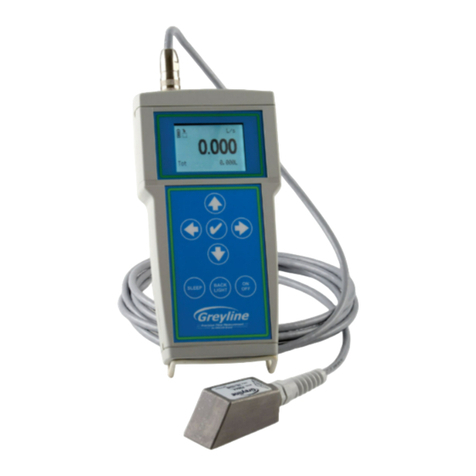
Greyline Instruments
Greyline Instruments A.1.2 Series user guide
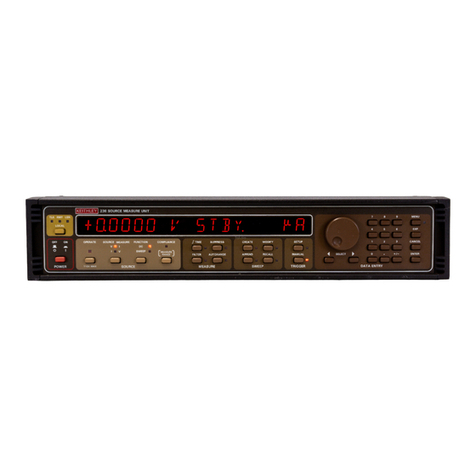
Keithley
Keithley 236 Service manual
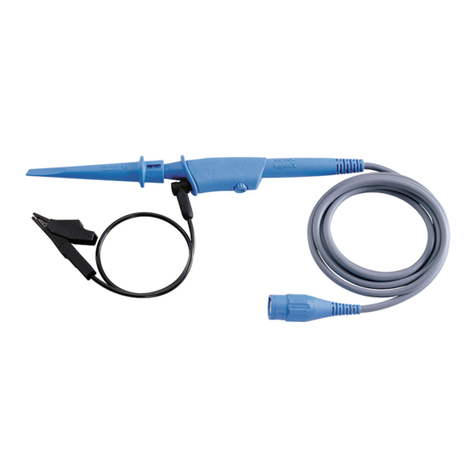
Hioki
Hioki 9666 instruction manual

Endress+Hauser
Endress+Hauser Prosonic S FMU95 operating instructions
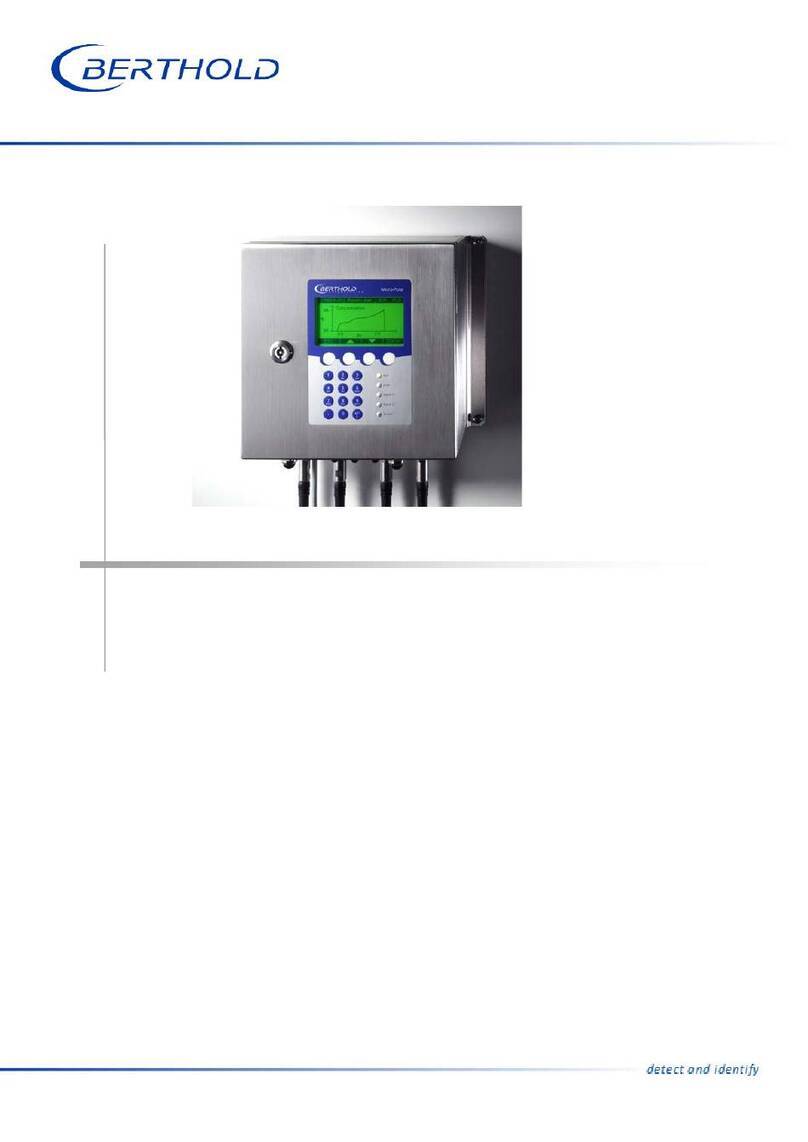
Berthold
Berthold MicroPolar Brix ++ LB 565 user guide

Spinner
Spinner BN 53 70 84 Handling & Cleaning Instructions
